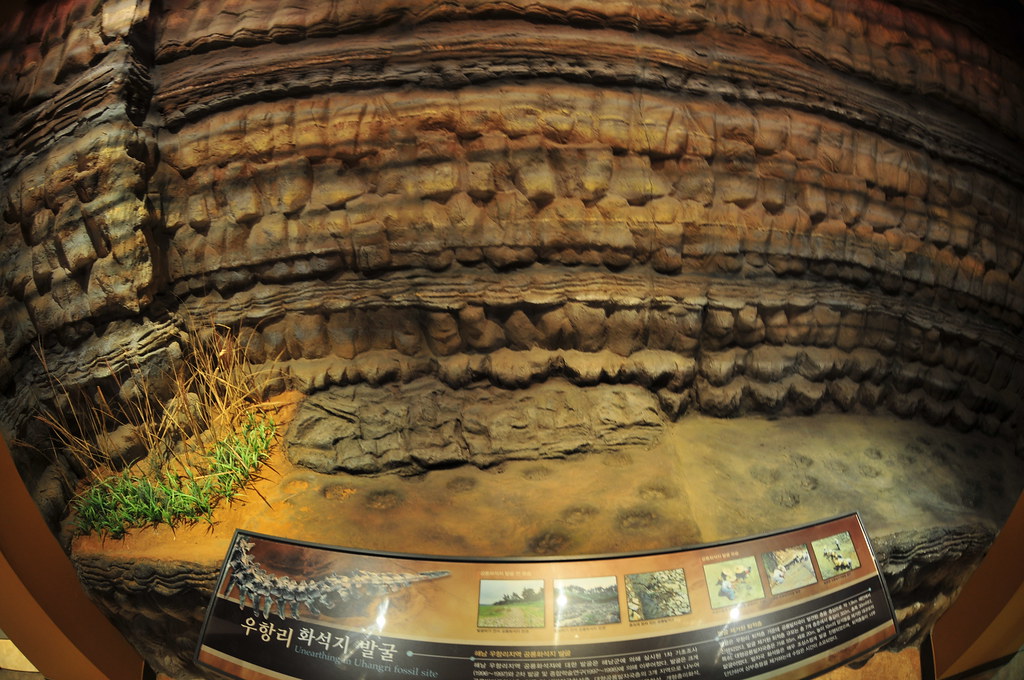10 April 2025
Uhangri Unleashed: Where Dinosaurs (Sort Of) Roam
Meanwhile in South Korea, dinosaurs brought back from extinction in a secret laboratory have broken out and are now roaming the Korean countryside, gobbling up the locals and generally doing the things that dinosaurs love to do. However, this particular de-extinction has been brought about courtesy of wire framing, concrete and fiberglass rather than gene-splicing. The Uhangri Dinosaur Center and Park - 해남공룡박물관 - may not host the real thing (it’s more of a visual, “colossal” fib but we're no strangers to that kind of thing, are we?) yet it’s still a great way to engage the public with all things cretaceous.
Why here? Dinosaur footprints – lots of them – were discovered in the Haenam county of South Korea (located in the far southwestern tip of the country), specifically around the Uhangri formation. That was in 1992 and since then the tracks of therapods, sauropods and ornithopods have been preserved in situ in the dinosaur museum that has been built over them. To attract visitors, the idea of dinosaurs breaking free was dreamed up by someone who had never seen a certain American film franchise – honest.
 At the
entrance to the small dinosaur museum, you'll spot life-sized models of
dinosaurs that appear to be bursting out of the building itself—like they
couldn’t be contained by four walls and a roof. The design is pure fun: parts
of the wall and ceiling look like they’ve been smashed open, with giant
dinosaur heads, claws, and tails sticking out at odd angles.
At the
entrance to the small dinosaur museum, you'll spot life-sized models of
dinosaurs that appear to be bursting out of the building itself—like they
couldn’t be contained by four walls and a roof. The design is pure fun: parts
of the wall and ceiling look like they’ve been smashed open, with giant
dinosaur heads, claws, and tails sticking out at odd angles.


 Back in the
Cretaceous period of the Mesozoic era, there were once three major lakes in
what is now Gyeongsang Province. Signs of those ancient lakes are still visible
along Korea’s southern coast—especially in Uhangri, Haenam-gun (Haenam county).
Back in the
Cretaceous period of the Mesozoic era, there were once three major lakes in
what is now Gyeongsang Province. Signs of those ancient lakes are still visible
along Korea’s southern coast—especially in Uhangri, Haenam-gun (Haenam county).

Uhangri was
originally part of the sea, but that changed when the Geumho Tide Embankment
was built, forming Damsuho Lake. The lake now has a 3-4 meter high sea cliff
stretching about 5 km, made of sedimentary rock dating back to the Cretaceous
period. Guess what was discovered in the
new sea cliff…


Evidence of life. What makes Uhangri truly special is what’s locked in that rock: fossilized footprints of dinosaurs, pterosaurs, and water birds that lived here millions of years ago. It’s the only site in the world where all three types of footprints have been found in one place. You can see how the cliff has been very cleverly incorporated into the museum below.


One
pterosaur footprint discovered here is the largest ever found, measuring 20–35
cm. And a fossil of a web-footed bird proves that these birds lived during the
Cretaceous- 20–30 million years earlier than similar fossils found in the U.S.
from the Eocene period. It is little
wonder that a park was developed to showcase the discoveries.


Around the park,
various dinosaurs that have already escaped can be found. The designs of these huge creations were
based on the most current research around dino-color and biomechanics. Inside, visitors can see the famous
footprints, as well as a multitude of state-of-the-art displays showcasing fossil
discoveries in Haenam county. The museum
provides materials and exhibitions related to dinosaurs as well
as Ulhang-ri as a natural heritage site.


The life-size
models certainly do the job. The Dinosaur Museum was founded to promote the
area's significance as a fossil site and the marketing department came up
trumps; the museum is hugely popular in South Korea. It’s safe to say - Uhangri’s dinosaurs
left more than just footprints; they’ve stomped their way into the spotlight.















